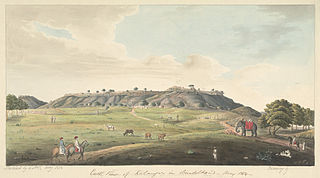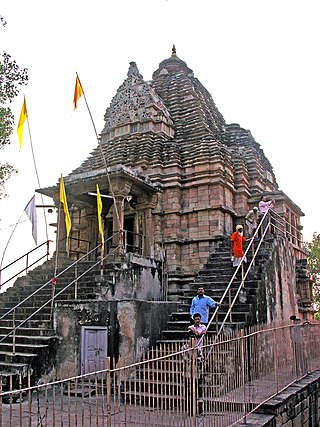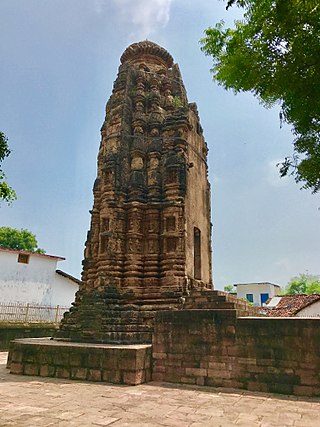
The Khajuraho Group of Monuments are a group of Hindu and Jain temples in Chhatarpur district, Madhya Pradesh, India. They are about 175 kilometres (109 mi) southeast of Jhansi, 10 kilometres (6.2 mi) from Khajwa, 9 kilometres (5.6 mi) from Rajnagar, and 49 kilometres (30 mi) from district headquarter Chhatarpur. The temples are famous for their Nagara-style architectural symbolism and a few erotic sculptures.

Verul Caves are a multi-religious rock-cut cave complex with artwork dating from the period 500 BCE, located in the Aurangabad District of Maharashtra, India. There are over 100 caves at the site, all excavated from the basalt cliffs in the Charanandri Hills, 34 of which are open to public. These consist of 17 Hindu, 12 Buddhist and 5 Jain caves. Each group represents deities and mythologies prevalent in the 1st millennium CE, as well as monasteries of each respective religion. They were built close to one another and illustrate the religious harmony that existed in ancient India. Because of their exceptional architecture of ancient India, the Ellora Caves were inscribed on the UNESCO World Heritage List in 1983.

Kalinjar is a fortress-city in Banda district of Uttar Pradesh, in India. It was ruled by several dynasties including the Guptas, the Vardhana Dynasty, the Chandelas, (Solankis) of Rewa, Mughal and the Marathas.

Aihole, also referred to as Aivalli, Ahivolal or Aryapura, is a historic site of ancient and medieval era Buddhist, Hindu and Jain monuments in Karnataka, India that dates from the sixth century through the twelfth century CE. Most of the surviving monuments at the site date from the 7th to 10th centuries. Located around an eponymous small village surrounded by farmlands and sandstone hills, Aihole is a major archaeological site featuring over one hundred and twenty stone and cave temples spread along the Malaprabha river valley, in Bagalakote district. Hunagunda Taluk Distance 35 km

Baran district is a district in the Indian state of Rajasthan. The headquarters of the district are located at the city of Baran.
Mangrol is a town with municipality and tehsil in Baran district in the Indian state of Rajasthan. Pincode of Mangrol is 325215. It is the nearby location of famous Ramgarh crater made from the meteorite strike, also famous for the 11th century rock temple Bhand Deva Temple.

The Kandariya Mahadeva Temple, meaning "the Great God of the Cave", is the largest and most ornate Hindu temple in the medieval temple group found at Khajuraho in Madhya Pradesh, India. It is considered one of the best examples of temples preserved from the medieval period in India. Because of its outstanding preservation and testimony to the Chandela culture, the temple was inscribed on the UNESCO World Heritage List in 1986.
Baran is a city in Baran district of the Indian state of Rajasthan. It is a municipality and the district headquarters of Baran district, famous for its 11th century Bhand Devra Temple on banks of Ramgarh crater. It is 339km from the state capital Jaipur near Kota city. Three large rivers, Parban, Parbati, and Kalisindh, flow through the district.

Bhumija is a variety of north Indian temple architecture marked by how the rotating square-circle principle is applied to construct the shikhara on top of the sanctum. Invented about the 10th-century in the Malwa region of central India during the Paramara dynasty rule, it is found in Hindu and Jain temples. Most early and elegant examples are found in and around the Malwa region, but this design is also found in Gujarat, Rajasthan, Deccan and some major Hindu temple complexes of southern and eastern India.

Dhosi Hill is an important Vedic period site, an extinct volcano, standing alone at the north-west end of the Aravalli mountain range. Its height varies from about 345 to 470 meters from the surrounding lands and 740 meters from the sea level. At present the hill has temples, a pakka pond, ruins of a fort, caves and forest around it. In the ancient times, as per various scriptures like Mahabharata - Vanparv, Puranas, Shathpath Brahmana etc. the hill had Ashrams of various Rishis who made contributions to Vedic scriptures.

Ramgarh crater, also known as Ramgarh structure, Ramgarh Dome and Ramgarh astrobleme, is a meteor impact crater of 3.5 kilometres (2.2 mi) diameter in Kota plateau of Vindhya range located adjacent to Ramgarh village in Mangrol tehsil of Baran district in Rajasthan state of India. When formally accepted as the third crater in India, its diameter size would be between the two already confirmed craters in India - Dhala in Madhya Pradesh with 14 km diameter and Lonar in Buldhana district of Maharashtra with 1.8 km diameter.
Dhala crater is a crater formed by an asteroid impact. It is situated near Bhonti village in Pichhore block of Shivpuri district of Madhya Pradesh state in India. It is the largest crater in India, and between the Mediterranean and Southeast Asia. The diameter of the structure is estimated at 3 km, while other sources estimate its diameter to be 11 km diameter. It is the second such crater found in India, after Lonar lake.

The Bhima Devi Temple Complex, nicknamed Khajuraho of North India for its erotic sculptures, comprises the restored ruins of an ancient Hindu temple dating from between 8th and 11th century AD, together with the adjacent 17th-century Pinjore gardens, located in Pinjore town in Panchkula district of the state of Haryana, India. The old temple was destroyed by Islamic invaders and the present 8-11th CE temple is likely built on the same place under the old name, and the nearby ancient baoli still has old Hindu pillars. Bhimadevi belongs to the Shakti tradition that was derived from the Buddhist tantric goddess. Further, in the Devi Mahatmya it is said that in the Western Himalayas of Himachal Pradesh, Bhimadevi appeared in an enormous form of Bhimarupa and gave protection to the sages. The site was worked upon extensively by the team of Speaking Archaeologically from 2017 to 2019, with preliminary survey beginning as early as in 2015 and the report was published as the Speaking Archaeologically Journal Volume III:Bhima Devi Project Edition in 2020.
Buhana is a tehsil (sub-district) and a municipality in the Jhunjhunu district of the Indian state of Rajasthan.

Nachna Hindu temples, also referred to as Nachana temples or Hindu temples at Nachna-Kuthara, in Panna district, Madhya Pradesh, India are some of the earliest surviving stone temples in central India along with those at Bhumara and Deogarh. Their dating is uncertain, but comparing their style to structures that can be dated, some of the Nachna temples are variously dated to the 5th- or 6th-century Gupta Empire era. The Chaturmukha temple is dated to the 9th century. These temples illustrate a North Indian style of Hindu temple architecture.

The Matangeshvara temple is a Shiva temple in the Khajuraho town of Madhya Pradesh, India. Among the Chandela-era monuments of Khajuraho, it is the only Hindu temple that is still actively used for worship. As part of the Khajuraho Group of Monuments, the temple was inscribed on the UNESCO World Heritage List in 1986 because of its art, architecture, and testimony to the Chandela culture.
Luna crater is an impact crater at Luna village in Bhuj taluka of Kutch district of Gujarat, India. The crater is located in a low-lying, soft, flat area and appears unconventional and deceptive when compared to other craters in India, which are usually found on hard, rocky surfaces.

Arang Jain temples is group of three Jain temples in Arang, Raipur, Chhattisgarh, India. These temples dates back to the 9th and 11th centuries.

Sirpur Group of Monuments are an archaeological and tourism site containing Hindu, Jain and Buddhist monuments from the 5th to 12th centuries in Mahasamund district of the state of Chhattisgarh, India. Located near an eponymous village, it is 78 kilometres (48 mi) east of Raipur, the capital of the state. The site is spread near the banks of the river Mahanadi.


















